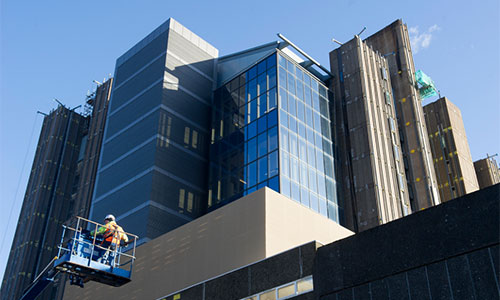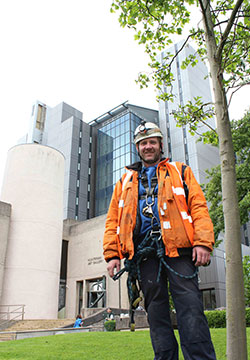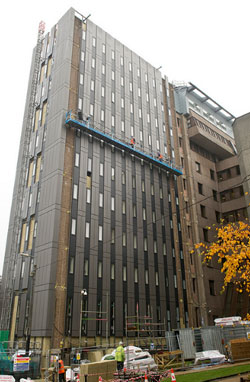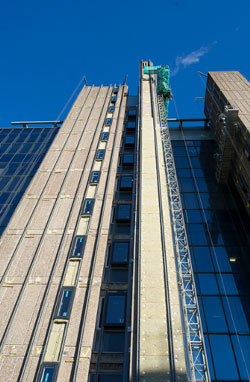Glasgow’s urban mountaineers
Published: 4 July 2013
Work on refurbishing the University of Glasgow Library in Hillhead Street is nearly at an end. For the past 17 months, teams of contractors have been making repairs to the original building with its six concrete towers, built in the mid-1960s.
Work on refurbishing the University of Glasgow Library in Hillhead Street is nearly at an end. For the past 17 months, teams of contractors have been making repairs to the original building with its six concrete towers, built in the mid-1960s. The University Library occupies one of the highest locations in the city. The latter part of the project has involved cladding the entire library structure in insulation and weather-screening aluminium panels to produce what appears to be a brand new building.

The University’s Estates and Buildings team worked with architects Nimmo and Partners Llp and one of the UK’s leading design and cladding specialists, D + B Facades.

But what on earth was it like for the teams of workers who had to brave the heights and the elements over a prolonged period? Mark Kelly, (42), from Stewarton in Ayrshire is one of the veterans of the project and a supervisor employed by the Glasgow firm Aspect Work at Height, which was responsible as a sub-contractor for all the abseiling elements of the project.
Mark began his high-flying career as a tree surgeon working on the railways. He moved to Aspect five years ago.
“Every job is different and very often we have to learn new skills associated with the particular job we are employed on,” says Mark. “We work closely with the other companies working on the project and cooperate with them to identify new ways of getting things done.”
“Working to repair the exterior of the Library and its towers, and to put in place the new cladding system was very demanding. Learning how to handle a hammer drill at 90 metres up in the air is quite a difficult thing!”
Mark explains how his involvement in the project started years earlier with an inspection of the library exterior, working with the University’s own Estates and Buildings team. “We had to work out what needed to be done and carefully inspected all the elevations of the Library. We had to do concrete repairs and work up new processes. We had to work on some of the steel fixtures and make those ready for the new cladding. What you see now took fifteen months of preparation.”
“Once we started work on the main task, our main problem was the wind speed. We can work through ice and snow...but it's the wind speed that determines whether we can go out on the towers or not. During the very cold early months of this year, the worst of the wind always seemed to come straight down the M8 motorway from the East.”
According to Mark and his fellow abseilers, the east-facing tower five was, in his words: “a real horror show”. He continues: Take it from me, being a human kite isn't good for the old heart! Of course we use wind speed measurement gauges, but sometimes it comes down to the individual. Some people will be comfortable up there working in 20 mile-an-hour winds… some won't.
“One risk we had to watch for was the possibility that we could damage the building ourselves just by being blown about and crashing into it, or having equipment we were hauling up the towers being blown around as well.

“For some of the guys in the team, it was the first time using some of the sophisticated rope and carabiner equipment, so they had a lot to learn.” Tongue in cheek, Mark says: “It can be quite funny watching people go white as they get used to new equipment!
The manner in which the abseiling crews accessed the towers would change day by day too, depending on the prevailing weather conditions. An added factor was the bleak spring of 2013 which proved to be the coldest in the UK for fifty years.
For some of the towers, the men from Aspect would have to use the freight elevators and then climb across the roof of the Archives. Other parts of the towers had their own access. On a bad day, the abseiling ropes would come over the top of the building and the climbing teams would have to start their day at ground level and work up. Says Mark: “A lot of people lost a lot of weight and gained a lot of muscle during the job.”
To be honest, the most dangerous moment was going over the edge to get on the rope in the first place. That short distance is when things can go wrong and you could slip and take a knock in the head. That is really the critical point.
The urban mountaineers working on the Library also had the occasionally surreal encounter with staff and students working inside the building. “We would get funny looks from time to time as we had to navigate past the windows at height. You could see them thinking: didn't you just come past me already?
“And sometime when we were taking breathers on the ground, we had students telling us we had the most amazing job in the world and asking us how they could get a job like ours! We'd tell them it's OK on a bright sunny day...but you wouldn't want to try it when the icy water is dripping down your back inside your overalls.
“In the coldest spells, our thermal clothing and gloves were very good, and if you could melt the ice where you were working it was OK. But if it was really bad then the work just couldn’t proceed.

“To be honest, the most dangerous moment was going over the edge to get on the rope in the first place. That short distance is when things can go wrong and you could slip and take a knock in the head. That is really the critical point.”
“At other times, you can find yourself working on one of the highest, most difficult sections of the Library and it is bright, sunny and calm first thing in the morning. But then when you are half way up or half way down the tower a little later, the wind will suddenly increase and pick you up and blow you round the other face of the building. You just have to hang on and say ‘here we go again!’”
There's an odd twist to Mark's story. Ask him about working at heights and he says: "To be honest with you, I always hated heights when I was a kid! Definitely as a boy I always hated it. And then later I did a diploma in horticulture and thought, I can't go on like this, so I started climbing trees and learning tree surgery.”
Mark says that despite the sometimes appalling weather conditions, it was an enjoyable job and the sort of project he'd happily repeat. For the next few weeks Mark and his colleagues will still be on the Library towers, completing some painting work. His next job? As yet he doesn't know what lies in store.
Such was the unusual and challenging nature of the University Library project, the partners involved, including Estates and Buildings, are planning to hold a construction industry site visit, to let other companies and specialists get a briefing on how such a complex and novel refurbishment was carried out with the minimal amount of disruption.
Robert Kilpatrick, Assistant Director (Estates Operations) said: “I am delighted with the end result of our main library project. To achieve this, D&B Facades along with their specialist sub contractors and suppliers have worked closely with Estates and Buildings, The Library and University Security staff as well as the project team lead by William Nimmo & Partners. The significant challenges of delivering such a complex project within a very busy, fully occupied building within the heart of our Gilmorehill campus cannot be overstated. Through all weathers, and many other challenges, all those involved have worked together to make it a success. Our main library building has been given a new lease of life in line with our strategic objectives of enhancing our student experience. Truly a team effort!”
First published: 4 July 2013
<< July

